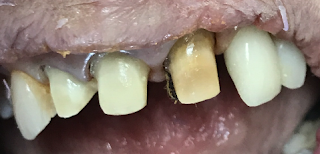Should I take the cord out?
I often help students at NYU College of Dentistry with their crown and bridge impressions. They usually are interested in my opinions about cord. "Do you use a double cord technique?" "Do you take out one or both cords before taking an impression?". It seems that some students are unclear about how to properly use cord to help take a final impression and I believe this post should be of help.
My answer about whether to use a double or single cord technique usually doesn't completely satisfy, since I am not particularly dogmatic. I explain that the sole purposes of retraction cord is to retract and to help stop bleeding by applying a slight pressure on the capillaries. I pack enough cord that the gum is slightly retracted. I usually place a small cord first, either 00 or 0. If my entire margin is then visible, I don't need a second slightly larger cord. If I can take an impression with the cord in, I do. If I can't, I take it out. If there is any bleeding, I will reapply Viscostat gently and then rinse with water without air spray. If there is even a little bleeding I repeat the application and rinse again. I do this repeatedly until I am able to dry the tooth with air , see the entire margin (without tissue tags contacting the finish line) and have no bleeding. At this point I am ready to take our impression.
Double cord technique is best employed when at least part of the finish line is subgingival, since more retraction is needed. The two cords are packed one on top of the other with the smaller cord packed first. Cord is always wet first with Viscostat ( I never pack dry). The larger cord just has to put pressure on the first cord so that it is pushed more subgingivally. The larger cord doesn't have to be fully packed under the gum, but must put some direct pressure on the smaller cord. Once packed, I place a wet two by two over the prep with the packed cord, have the patient bite down and wait four minutes.
During the wait I have the student set up their impression materials and paint the impression tray with an appropriate adhesive ( NO Alginate Adhesive PLEASE!) . At the end of the four minutes I ask the patient to open their mouths and usually I place a bite block on the contralateral side. I usuallly place cotton rolls on either side of the teeth that are to be impressioned. At this point I wash the preps and make sure all the coagulum debris is off the prep(s). I leave the cord wet with water afterwards and gently tease out the cord. If there is bleeding, I will reapply Viscostat until the bleeding stops . If the smaller first cord is not covering the margin of the prep, I carefully dry the prep and take my impression. If the margin is not fully visible, I rewet the remaining cord with water and remove it. after it is removed I gently wash the prep and then dry using the air syringe. If there isn't any bleeding I take the impression. If there is bleeding I reapply Vryiscostat. until the bleeding stops.
That is my basic technique. If I miss my impression because of moisture contamination, or the student moved the tray while it was setting or because there is a void. I often repack my cords, making sure to re- wet them with Viscostat first. Since I do not own a laser or even an electrosurgery unit, I do not employ them to facilitate the taking of final impressions. One way or the other I am able to get a clear impression (sometimes it take me multiple try before succeeding) If I have left something out or if readers have any questions they should feel free to email me at lawrencespindel@yahoo.com.
from Ask Dr. Spindel - http://lspindelnycdds.blogspot.com/2019/09/should-i-take-cord-out.html - http://lspindelnycdds.blogspot.com/


Comments
Post a Comment